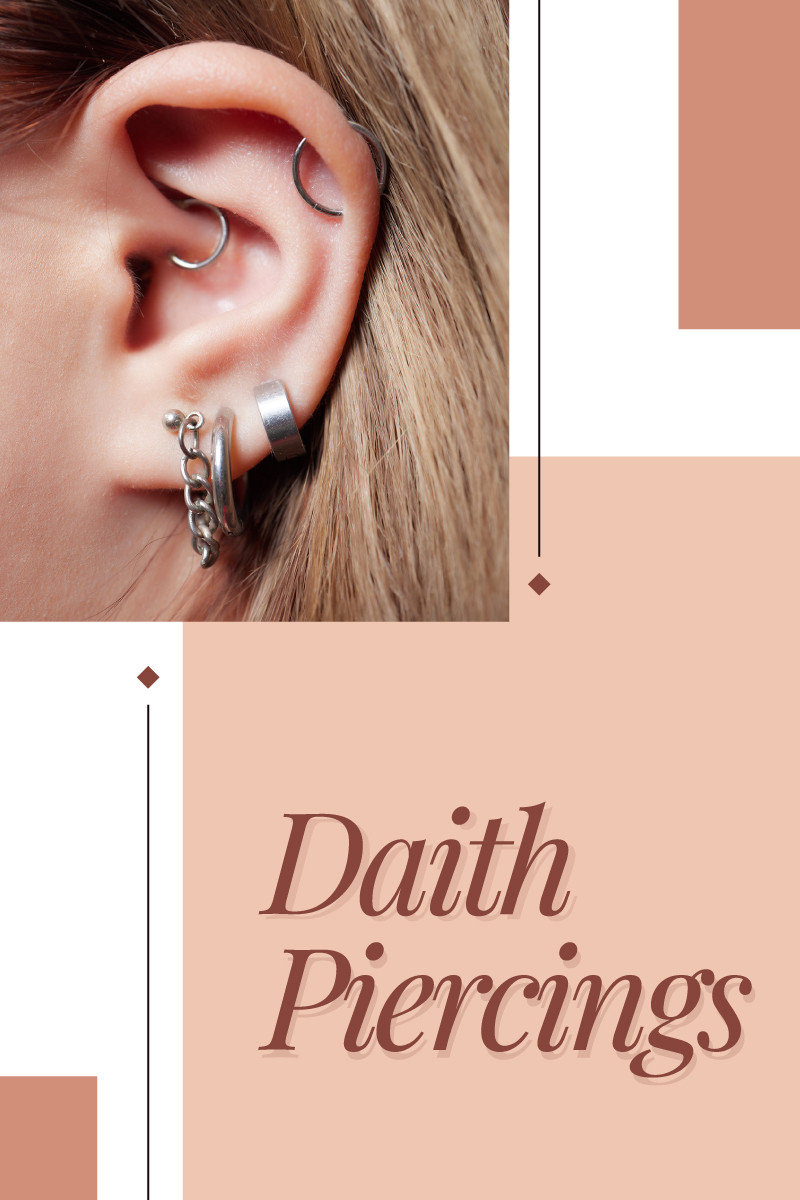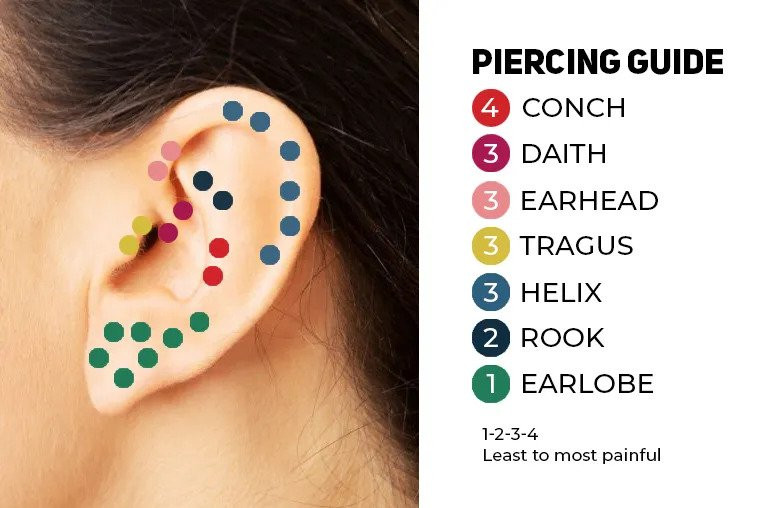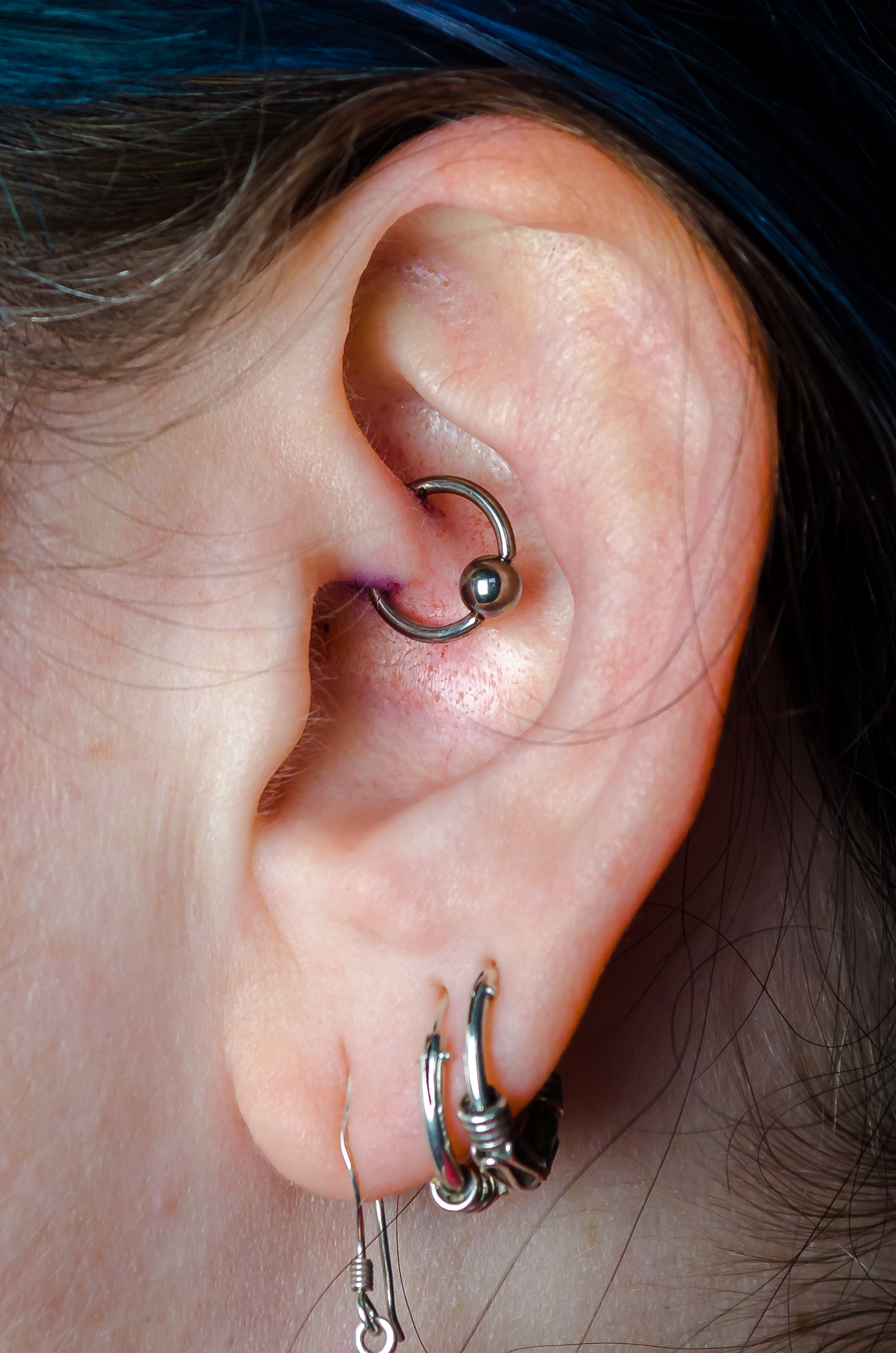
Daith Piercings Guide
 Are you thinking about upgrading your look with a daith piercing? Or maybe you already have one and want to learn more about it? Either way, you’ve come to the right place!
Are you thinking about upgrading your look with a daith piercing? Or maybe you already have one and want to learn more about it? Either way, you’ve come to the right place!
Whether you're a piercing novice or a seasoned pro, it’s not hard to see why daith piercings have become so popular.
Hint: It's not just because they look stylish and trendy.
Struggle with anxiety? Migraines bringing you down? It turns out daith piercings may actually boast some surprising health benefits too.
A piercing that elevates your ear game and your well-being? Yes, please!
So what do I need to know before getting a daith piercing?
Our Daith Piercings Guide is here to fill you in on everything you need to know about daith piercings, from pain and healing to potential benefits, jewelry options, aftercare, and more.

What Is a Daith Piercing?
A daith piercing is a piercing (usually a hoop) that hugs the little cartilage fold right above the entrance of your ear canal.
The daith piercing may be a relatively new addition to the piercing scene, but it has quickly gained popularity since its inception in the early 1990s. Piercer Erik Dakota was the first to perform the piercing in Santa Cruz, California.
The daith piercing’s unique moniker, pronounced like "moth" or "goth" (not like "faith"), was coined by Dakota’s client, a woman studying Hebrew in college. She named the piercing da'at, which translates to “intelligence” or “knowledge” in Hebrew (דעת [ˈdaʕaθ]) because she believed the piercer must’ve been very "smart" to figure out how to perform such a tricky piercing.
The name and pronunciation stuck — the daith piercing has been a popular choice among body-modification enthusiasts ever since!
Where is the Daith Located?
You can find the daith piercing location situated in the thick, firm ridge of cartilage adjacent to your ear canal and close to the cheek, called the Crus Helix.
Having trouble spotting it? Grab a mirror and look at your ear — that innermost fold of the ear cartilage, just above the ear canal, is your daith!
It's a unique and attractive location that sets it apart from other piercings.
But for it to be considered a true daith piercing, it has to be done a certain way.
The bottom part of the ring should appear to come directly out of the ear canal, giving the illusion that there’s no entry or exit. If the entrance and exit holes of the ring are visible, it’s technically not a true daith piercing.
So is a daith piercing painful? Let’s find out.
 Image credit: Soul Factors
Image credit: Soul Factors
How Painful is a Daith Piercing?
Let’s be honest — there’s often some level of uneasiness when you’re getting a new piercing.
Daith piercings are generally considered one of the most painful ear piercings you can get, right up there with a septum piercing. Why? Because the piercing is placed on a much thicker and firmer area (the cartilage), where you'll always experience more resistance.
Piercing through the thick cartilage wall requires a bit more pressure to be applied by the piercer than in other areas. While the pain might not be extreme for many, the sound that follows is often what startles people.
Keeping things in perspective, it’s easy to understand why a daith piercing sounds so loud: it’s the closest piercing you can get next to your eardrum, after all!
That being said, everyone’s pain tolerance is different. What may be harrowing to you may be totally bearable for your friend.
The good news is that the entire process is a quick moment of pain (and maybe a little eye-watering), then voila! You’re off to face the world with a super cool daith piercing.
Just don’t forget to let it heal properly before changing your jewelry.
How Long Does a Daith Take to Heal?
Like pain tolerance, healing time varies from person to person.
If you take proper care of your daith piercing, most piercers agree you can expect it to fully heal within 6 to 12 months.
And, nope, that doesn’t mean your piercing will feel ultra-sensitive throughout the healing process, but you might experience minor soreness.
Just be sure you follow your piercer’s aftercare instructions, and you’ll be good to go!
Speaking of aftercare…
Aftercare for Your Daith Piercing
As you heal, you might have some questions: is it hard to sleep with a daith piercing? Can I wear earbuds with a daith piercing? Do I have to avoid touching my ear? …and so forth.
While you shouldn’t feel any prolonged irritation after your piercing, a little soreness or discomfort is totally normal. This might make things like sleeping, wearing earbuds, styling your hair, or even showering a bit tricky.
But don’t worry — your piercer will give you a comprehensive breakdown of how to best care for your new daith piercing.
Your aftercare instructions will probably be something along these lines:
Gently clean your piercing at least twice a day with unscented soap or saline.
Avoid rubbing alcohol, hydrogen peroxide, and ointments.
Avoid sleeping on your piercing, as well as touching or twisting it.
Be careful with your piercing catching on shirts, pillowcases, or towels.
They’ll also fill you in on how long after you get your daith piercing you can change it out to new jewelry (generally once it’s fully healed).
The daith piercing may come with a momentary pinch of pain, but we promise — the payoff is worth it!
 Image credit: Salt of the Earth
Image credit: Salt of the Earth
What Are the Benefits of a Daith Piercing?
Besides the edgy aesthetic, what does a daith piercing represent?
According to ancient Hindu beliefs, an orifice body piercing (like the daith piercing) was thought to act as a “Guardian of the Gate,” a way to filter out unimportant information and allow only intelligent thoughts to enter the mind.
As for physical wellness, some anecdotal evidence suggests that daith piercings may reduce migraines and anxiety via acupressure.
If you’re not familiar, acupressure is a Chinese medicine technique that involves applying pressure to specific “trigger points” on your body to relieve pain and promote healing.
These points are located along pathways called meridians and are believed to carry energy (or qi) throughout the body. Applying pressure to these points stimulates the flow of qi, helping to restore balance to the body.
So, how is a daith piercing good for anxiety and migraines?
Your vagus nerve, located on the daith, is the trigger point for anxiety and migraines. The idea is that the daith piercing keeps constant pressure on your vagus nerve, thereby alleviating anxiety and migraines.
Think you can rock a daith piercing? It all comes down to anatomy!
Will a Daith Piercing Suit my Ear Shape?
Whether a daith piercing suits you depends on your ear shape, ear size, and personal preference.
The easier it is for a piercer to access your daith, the better-suited you are to get it pierced. If your ears are smaller or the space around your daith is more compact, it could be more challenging for your piercer to access the area.
That said, there are no fixed rules about which ear shapes best suit daith piercings. Ultimately, it’s up to you and your piercer to decide if a daith piercing is the right choice!
Ready to budget for your new piercing? Let’s talk price.
How Much Does a Daith Piercing Cost?
As far as cost goes, daith piercings usually aren’t more expensive than any other inner-ear cartilage piercing.
The cost varies mostly depending on where you go and what kind of jewelry you choose to dress up your ear.
On average, you can expect to pay between $30 to $80 — plus the cost of jewelry, which usually starts around $30, and any additional tax.
Now that you know how much a daith piercing costs, let's dive into the fun stuff – what kind of jewelry can you rock in your new piercing?
Daith Piercing Jewelry Options
With the rising popularity of daith piercings, different jewelry options are popping up every day. From sleek and simple to bold statement pieces, there's a style to suit every taste.
And if you’re wondering which side do you get a daith piercing — it’s entirely up to you!
With so many choices, it can be tough to narrow down your preferred style of daith jewelry.
Here’s the lowdown on some of the most popular daith jewelry styles to help you find your quintessential match.
 Image credit: Prikdpeterrobin on Instagram
Image credit: Prikdpeterrobin on Instagram
Hoops for Daith Piercings
When you first get your daith pierced, you’ll likely start with a 16-gauge hoop until your piercing completely heals. This helps to avoid irritation or infection from unwanted pressure on your fresh piercing.
Even though they’re the first type of daith jewelry you get, many love their aesthetic and versatility, opting to keep their hoops long after the piercing has healed.
While this option offers a seemingly understated appeal, it comes in many styles. From minimal metal to intricate gemstone-encrusted ones, the daith hoop ring is one of the most popular options.
Not a fan? Once your daith fully heals, you’ve got a green light to experiment with all kinds of daith jewelry styles!
 Image credit: Enrique Íñiguez Medina | Creative Commons Attribution-Share Alike 3.0 Unported license
Image credit: Enrique Íñiguez Medina | Creative Commons Attribution-Share Alike 3.0 Unported license
Daith Piercing Clickers
Clicker earrings are similar to hoops in aesthetic but have a clicking mechanism that springs open for easy application and removal — perfect for beginners.
Named for the way they click open and close, clickers are also a popular jewelry option for septum piercings. In fact, most septum clickers will likely fit your daith piercing!
Thanks to their ease of use, clickers are a great option for personalizing and experimenting with different styles.
 Image credit: Talisman Tattoo
Image credit: Talisman Tattoo
Heart-Shaped Daith Rings
What’s cuter than a heart hugging your new daith piercing?
As the name implies, these earrings are heart-shaped hoops that look lovely and give your daith piercing a little love. They’re perfect for adding a touch of softness or femininity to the edgy daith piercing.
But these dainty, delicate hearts aren’t just for the ladies — men can rock them, too!

Barbell Daith Piercing Jewelry
Barbell daith jewelry consists of a metal bar with removable balls on either end, resembling a weightlifting barbell. To put it in, you simply remove one ball, slide the bar through the piercing, and secure the ball back on.
Barbell jewelry is available in several styles, mainly:
Circular barbells
Straight barbells
Curved barbells
A curved barbell can be especially effective for a daith piercing, as it follows the natural contours of the ear.
Whether you opt for a classic straight barbell or a more eclectic curved design, a barbell is an excellent choice for a sleek and stylish daith piercing.
Daith Piercing Jewelry Material
Whenever you get a new piercing, you want to remember that certain materials can irritate your piercing or prolong your healing time.
The best options for daith piercing jewelry (at least, initially) are hypoallergenic metals.
Implant-grade materials like stainless steel, niobium, and titanium won't break down or irritate your piercing. And the best part? They have way less nickel than surgical steel, so you can rock your new piercing without worrying about any allergic reactions.
Upgrade Your Ear Jewelry with a Daith Piercing!
Daith piercings are the ultimate accessory for any fashion-forward dude or chick with an affinity for eclectic ear jewelry.
Not only do they add a one-of-a-kind touch to any aesthetic, but they may deliver an unexpected boost to your overall wellness — who wouldn’t want that?
With such a diverse selection of jewelry options out there, switching up your daith piercing to match your mood and ever-evolving style has never been easier!
Ready to curate your ear with a daith piercing of your own?
Search the Fashion Encyclopedia
Related Auctions
Related Articles
A guide on buying loose Opals for Jewelry. Doublets and Triplets are perfect for making Jewelry with but there are factors you need to be aware of.
3rd Oct 2019
Rhodium plating jewelry adds a brighter white finish, protection from scratches, and greater longevity. Learn about the pros, cons, value, and proper care of rhodium-plated jewelry.
27th Feb 2019
Thinking of getting your nose pierced? Metals run the gamut from high-quality and safe, to flat out painful health risks. It’s important to learn the best and worst metals for nose rings
2nd Apr 2019
Latest Articles
Titanium is a popular jewelry metal known for being lightweight, durable, and affordable. Learn all about titanium, how it compares to similar metals, and the pros and cons of titanium jewelry.
7th Feb 2023
Learn all about tungsten jewelry - from its history and uses to its durability and care. By the end of our guide, you’ll know if tungsten is right for you!
7th Feb 2023
Thinking about adding some timeless white gold jewelry to your fine accessories collection? Here’s all there is to know about sophisticated white gold!
29th Jan 2023


